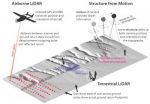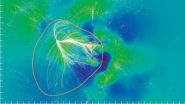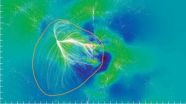(Press-News.org) Boulder, Colo., USA – Using high-resolution topography models not available in the past, geologists can greatly enrich their research. However, current methods of acquisition are costly and require trained personnel with high-tech, cumbersome equipment. In light of this, Kendra Johnson and colleagues have developed a new system that takes advantage of affordable, user-friendly equipment and software to produce topography data over small, sparsely vegetated sites at comparable (or better) resolution and accuracy to standard methods.
Their workflow is based on structure from motion (SfM), which uses overlapping photographs of a scene to produce a 3-D model that represents the shape and scale of the terrain. To acquire the photos, Johnson and colleagues attached a camera programmed to take time-lapse photos to a helium balloon or small, remote-controlled glider. They augmented the aerial data by recording a few GPS points of ground features that would be easily recognized in the photographs.
Using a software program called Agisoft Photoscan, they combined the photographs and GPS data to produce a robust topographic model.
Johnson and colleagues note that this SfM workflow can be used for many geologic applications. In this study for GEOSPHERE, Johnson and colleagues focused on its potential in studying active faults that pose an earthquake hazard.
They targeted two sites in southern California, each of which has existing topography data collected using well-established, laser-scanning methods.
The first site covers a short segment of the southern San Andreas fault that historically has not had a large earthquake; however, the ground surface reveals evidence of prehistoric ruptures that help estimate the size and frequency of earthquakes on this part of the fault. The team notes that this evidence is more easily quantified using high-resolution topography data than by geologists working in the field.
The second site covers part of the surface rupture formed during the 1992 Landers earthquake (near Palm Springs, California, USA). Johnson and colleagues chose this site to test the capability of their workflow as part of the scientific response that immediately follows an earthquake.
At each site, they compared their SfM data to the existing laser scanner data and found that the values closely matched. Johnson and colleagues conclude that their new SfM workflow produces topography data at sufficient quality for use in earthquake research.
FEATURED ARTICLE
Rapid mapping of ultra-fine fault zone topography with structure from motion
Kendra Johnson et al., Dept. of Geophysics, Colorado School of Mines, 1500 Illinois Street, Golden, Colorado 80401, USA. Posted online 29 Aug. 2014; http://dx.doi.org/10.1130/GES01017.1.
Other GEOSPHERE articles (see below) cover such topics as
1. Evidence for a marine incursion along the lower Colorado River corridor;
2. The ANDRILL McMurdo Ice Shelf (MIS) and Southern McMurdo Sound (SMS) Drilling Projects;
3. Origin and Evolution of the Colorado River System; and
4. Tectonic activity reflected in the Cook Strait submarine canyon system, New Zealand.
All GEOSPHERE articles available at http://geosphere.gsapubs.org/. Representatives of the media may obtain complimentary copies of GEOSPHERE articles by contacting Kea Giles at the address above. Please discuss articles of interest with the authors before publishing stories on their work, and please make reference to GEOSPHERE in articles published. Non-media requests for articles may be directed to GSA Sales and Service, gsaservice@geosociety.org.
Evidence for a marine incursion along the lower Colorado River corridor
Kristin McDougall, Geology, Minerals, Energy, and Geophysics Science Center, U.S. Geological Survey, 2255 N. Gemini Drive, Flagstaff, Arizona 86001, USA; and Adriana Yanet Miranda Martínez, Posgrado en Ciencias de la Tierra, Instituto de Geología, Universidad Nacional Autónoma de México, México D.F. C.P. 04510, México. Published online 29 Aug. 2014; http://dx.doi.org/GES00971.1. Themed issue: CRevolution 2: Origin and Evolution of the Colorado River System II.
From the abstract: Foraminiferal assemblages in the stratigraphically lower part of the Bouse Formation in the Blythe basin (lower Colorado River corridor, western USA) indicate marine conditions, whereas assemblages in the upper part of the Bouse Formation indicate lacustrine conditions and suggest the presence of a saline lake. Benthic foraminiferal assemblages in the lower part of the Bouse Formation are similar to lagoonal and inner neritic biofacies of the modern Gulf of California. Evidence suggesting a change from marine to lacustrine conditions includes the highest occurrence of planktic foraminifers at an elevation of 123 m above sea level (asl), the change from low diversity to monospecific foraminiferal assemblages composed only of Ammonia beccarii (between 110 and 126 m asl), and an increase in abundance of A. beccarii specimens (above ~110 m asl).
Application of LiDAR to resolving tectonic and glacial fabrics in glaciated terrain: An example from an Archean granite-greenstone belt, northeastern Minnesota
Jonathan Dyess and Vicki L. Hansen, Dept. of Geological Sciences, University of Minnesota Duluth, 1114 Kirby Drive, 229 Heller Hall, Duluth, Minnesota 55812, USA. Published online 29 Aug. 2014; http://dx.doi.org/GES00984.1.
This contribution illustrates the application of Light Detection and Ranging (LiDAR) elevation data to mapping geologic structural patterns across vast inaccessible glaciated regions where traditional remote sensing datasets, such as aerial photography or satellite imagery, are commonly ineffectual due to dense vegetative cover. We outline a new approach to recognizing and mapping topographic lineaments and distinguish between lineaments controlled by the bedrock geologic structure and lineaments controlled by surficial glacial processes. Using these topographic lineaments, we interpret regional structural patterns for an area of northeastern Minnesota. Techniques outlined in the contribution provide a new remote sensing-based approach to mapping regional geologic structures in glaciated regions, and have significant applications in structural geology including: (1) Constructing preliminary regional tectonic maps from limited field observations, allowing for the formation and testing of structural models. (2) Directing field work to areas of interest to test structural models, making field work more efficient and decreasing field time. (3) Providing insight into inaccessible areas or areas of poor exposure. (4) Illustrating first-order cross-cutting relationships and relative timings. (5) Placing detailed map areas into a broad regional structural context.
Uppermost mantle velocity from Pn tomography in the Gulf of Aden
Jordane Corbeau et al., Sorbonne Universités, UPMC Univ. Paris 06, UMR 7193, Institut des Sciences de la Terre Paris (iSTeP), F-75005 Paris, France. Posted online 18 Aug. 2014; http://dx.doi.org/10.1130/GES01052.1. Themed issue: Anatomy of Rifting: Tectonics and Magmatism in Continental Rifts, Oceanic Spreading Centers, and Transforms.
The Gulf of Aden, situated between Arabia and Africa, is the witness of the oceanic opening first steps. In the west of the Gulf, we found a hotspot called the Afar hotspot. Here we are looking for the relation between the hot material produced by the hotspot and the Gulf of Aden ridges, based on the study of seismical waves. We provide evidence that deep material undergoes a channelized flow from Afar hotspot toward the east along the oceanic ridges.
Kinematics of the Neogene Terror Rift: Constraints from calcite twinning strains in the ANDRILL McMurdo Ice Shelf (AND-1B) core, Victoria Land Basin, Antarctica
Timothy S. Paulsen et al., Dept. of Geology, University of Wisconsin Oshkosh, 800 Algoma Boulevard, Oshkosh, Wisconsin 54901, USA. Posted online 18 Aug. 2014; http://dx.doi.org/10.1130/GES01002.1. Themed issue: The ANDRILL McMurdo Ice Shelf (MIS) and Southern McMurdo Sound (SMS) Drilling Projects.
The Antarctic plate formed when the Gondwana supercontinent broke up, which was largely completed by ~80 million years ago. Rifting episodes have happened repeatedly within the plate since that time, but the associated intraplate motions are poorly known. These motions are important, however, for understanding plate break-up mechanisms and Mesozoic to Cenozoic global plate motions. Paulsen et al. present new data constraining the intraplate motions during the young "Terror Rift" deformation from 13.6 to 4.3 million years ago. Shortening and extension directions were measured from mechanical twins in calcite filling fractures cutting sedimentary and volcanic rocks recovered by the ANDRILL (ANtarctic geologic DRILLing) McMurdo Ice Shelf (MIS) AND-1B drill core. Results show dominant subvertical shortening, a northwest-southeast stretching direction, and no significant horizontal shortening. Vertical shortening was induced by sedimentary and ice sheet loading and horizontal stretching is most likely related to extension orthogonal to Terror Rift, but could also be due to partitioning of deformation in an extensional regime that includes a component of strike-slip motion.
Rhyolites—Hard to produce, but easy to recycle and sequester: Integrating microgeochemical observations and numerical models
I.N. Bindeman, Dept. of Geological Sciences, 1272 University of Oregon, Eugene, Oregon 97403, USA; and A.G. Simakin, Institute of the Physics of the Earth, Bolshaya Gruzinskaya 10, Moscow. Published online 29 Aug. 2014; http://dx.doi.org/GES00969.1. Themed issue: Cenozoic Tectonics, Magmatism, and Stratigraphy of the Snake River Plain–Yellowstone Region and Adjacent Areas.
From the abstract: Recent discoveries of isotopically diverse minerals (i.e., zircons, quartz, and feldspars) in large-volume ignimbrites and smaller lavas from the Snake River Plain (SRP; Idaho, USA), Iceland, Kamchatka Peninsula, and other environments suggest that this phenomenon characterizes many silicic units studied by in situ methods. This observation leads to the need for new models of silicic magma petrogenesis that involve double or triple recycling of zircon-saturated rocks.
The endogeneous and exogenous growth of the monogenetic Lemptégy volcano, Chaîne des Puys, France
Audray Delcamp et al., Dept. of Geography, Earth System Science, Vrije Universiteit Brussel, Pleinlaan 2, 1050 Brussels, Belgium. Posted online 18 Aug. 2014; http://dx.doi.org/10.1130/GES001007.1.
From the abstract: The monogenetic Lemptégy volcano in the Chaîne des Puys (Auvergne, France) was quarried from 1946 to 2007 and offers the possibility to study scoria cone architecture and evolution. This volcano was originally 50 to 80 m high, but scoria excavation has resulted in a 50-m-deep hole. Beginning in the 1980s, extraction was carried out with the advice of volcanologists so that Lemptégy's shallow plumbing system and three-dimensional stratigraphy have been preserved. Detailed mapping enabled key stratigraphic units to be distinguished and the constructional phases to be reconstructed.
Geomorphic response of submarine canyons to tectonic activity: Insights from the Cook Strait canyon system, New Zealand
Aaron Micallef et al., Dept. of Physics, Faculty of Science, University of Malta, Msida, MSD 2080, Malta. Posted online 18 Aug. 2014; http://dx.doi.org/10.1130/GES01040.1. Themed issue: Exploring the Deep Sea and Beyond, Volume 2.
From the abstract: Active margins host more than half of submarine canyons worldwide. Understanding the coupling between active tectonics and canyon processes is required to improve modeling of canyon evolution and derive tectonic information from canyon morphology. In this paper we analyze high-resolution geophysical data and imagery from the Cook Strait canyon system (CS), offshore New Zealand, to characterize the influence of active tectonics on the morphology, processes, and evolution of submarine canyons, and to deduce tectonic activity from canyon morphology.
INFORMATION:
Contact: Kea Giles
+1-303-357-1057
kgiles@geosociety.org
http://www.geosociety.org/
Team develops new, inexpensive method for understanding earthquake topography
New Geosphere articles posted online
2014-09-03
ELSE PRESS RELEASES FROM THIS DATE:
Study sets guideline for determining effectiveness of college football training methods
2014-09-03
VIDEO:
Athletic performance varies from day to day, which can make it difficult for strength and conditioning professionals to judge whether athletes' improvements are due to effective training. Now, University of...
Click here for more information.
COLUMBIA, Mo. –Athletic performance varies from day to day, which can make it difficult for strength and conditioning professionals to judge whether athletes' improvements are due to effective training. Now, University of Missouri ...
NIH-led scientists discover HIV antibody that binds to novel target on virus
2014-09-03
WHAT:
An NIH-led team of scientists has discovered a new vulnerability in the armor of HIV that a vaccine, other preventive regimen or treatment could exploit. The site straddles two proteins, gp41 and gp120, that jut out of the virus and augments other known places where broadly neutralizing antibodies (bNAbs) bind to HIV. This newly identified site on the viral spike is where a new antibody found by the scientists in an HIV-infected person binds to the virus. Called 35O22, the antibody prevents 62 percent of known HIV strains from infecting cells in the laboratory and ...
Hawaii scientist maps, names Laniakea, our home supercluster of galaxies
2014-09-03
University of Hawaii at Manoa astronomer R. Brent Tully, who recently shared the 2014 Gruber Cosmology Prize and the 2014 Victor Ambartsumian International Prize, has led an international team of astronomers in defining the contours of the immense supercluster of galaxies containing our own Milky Way. They have named the supercluster "Laniakea," meaning "immense heaven" in Hawaiian. The paper explaining this work is the cover story of the September 4 issue of the prestigious journal Nature.
Galaxies are not distributed randomly throughout the universe. Instead, they are ...
Sequencing of 5 African fishes reveals diverse molecular mechanisms underlying evolution
2014-09-03
Cambridge, MA. Wed. September 3, 2014 — In an effort to understand the molecular basis of adaptation in vertebrates, researchers sequenced the genomes and transcriptomes of five species of African cichlid fishes. A research team led by scientists at the Broad Institute of MIT and Harvard uncovered a variety of features in the cichlid genomes that enabled the fishes to thrive in new habitats and ecological niches within the Great Lakes of East Africa. In addition to helping explain the complex genomic mechanisms that give rise to incredible diversity among cichlid fishes, ...
Airlock-like transport protein structure discovered
2014-09-03
Palo Alto, CA—Sugars are an essential source of energy for microrganisms, animals and humans. They are produced by plants, which convert energy from sunlight into chemical energy in the form of sugars through photosynthesis.
These sugars are taken up into cells, no matter whether these are bacteria, yeast, human cells or plant cells, by proteins that create sugar-specific pores in the membrane that surrounds a cell. These transport proteins are thus essential in all organisms. It is not surprising that the transporters of humans and plants are very similar since they ...
Carbon stored in the world's soils more vulnerable to climate change than expected
2014-09-03
The response of soil microbial communities to changes in temperature increases the potential for more carbon dioxide to be released from the world's soils as global temperatures rise, scientists have revealed.
The potential for global warming to stimulate decomposition rates in soils, and thus release large quantities of carbon dioxide to the atmosphere, has long been considered to be one of the potentially most important positive feedbacks to climate change. However, the results from more recent studies have suggested that responses within microbial communities could ...
Study shows cellular RNA can template DNA repair in yeast
2014-09-03
The ability to accurately repair DNA damaged by spontaneous errors, oxidation or mutagens is crucial to the survival of cells. This repair is normally accomplished by using an identical or homologous intact sequence of DNA, but scientists have now shown that RNA produced within cells of a common budding yeast can serve as a template for repairing the most devastating DNA damage – a break in both strands of a DNA helix.
Earlier research had shown that synthetic RNA oligonucleotides introduced into cells could help repair DNA breaks, but the new study is believed to be ...
Newly identified galactic supercluster is home to the Milky Way
2014-09-03
Astronomers using the National Science Foundation's Green Bank Telescope (GBT) -- among other telescopes -- have determined that our own Milky Way galaxy is part of a newly identified ginormous supercluster of galaxies, which they have dubbed "Laniakea," which means "immense heaven" in Hawaiian.
This discovery clarifies the boundaries of our galactic neighborhood and establishes previously unrecognized linkages among various galaxy clusters in the local Universe.
"We have finally established the contours that define the supercluster of galaxies we can call home," said ...
Longitudinal study explores white matter damage, cognition after traumatic axonal injury
2014-09-03
Traumatic Axonal Injury is a form of traumatic brain injury that can have detrimental effects on the integrity of the brain's white matter and lead to cognitive impairments. A new study from the Center for BrainHealth at The University of Texas at Dallas investigated white matter damage in the acute and chronic stages of a traumatic axonal injury in an effort to better understand what long-term damage may result.
The study, published online July 21 in the Journal of Neurotrauma, looked at 13 patients ages 16 to 60 with mild to severe brain injuries from the intensive ...
Bariatric surgical center accreditation improves patient survival and postop complications
2014-09-03
CHICAGO (September 3, 2014): Patients who underwent weight loss operations in recent years, when most bariatric surgical centers were accredited, had fewer postoperative complications and were 2.3 times less likely to die in the hospital than patients who had bariatric procedures performed before a national movement toward facility accreditation was taking place, according to new study findings. Study authors, who published their results in the September issue of the Journal of the American College of Surgeons, say these findings suggest that accreditation of bariatric ...
LAST 30 PRESS RELEASES:
Survey reveals ethical gaps slowing AI adoption in pediatric surgery
Stimulant ADHD medications work differently than thought
AI overestimates how smart people are, according to HSE economists
HSE researchers create genome-wide map of quadruplexes
Scientists boost cell "powerhouses" to burn more calories
Automatic label checking: The missing step in making reliable medical AI
Low daily alcohol intake linked to 50% heightened mouth cancer risk in India
American Meteorological Society announces Rick Spinrad as 2026 President-Elect
Biomass-based carbon capture spotlighted in newly released global climate webinar recording
Illuminating invisible nano pollutants: advanced bioimaging tracks the full journey of emerging nanoscale contaminants in living systems
How does age affect recovery from spinal cord injury?
Novel AI tool offers prognosis for patients with head and neck cancer
Fathers’ microplastic exposure tied to their children’s metabolic problems
Research validates laboratory model for studying high-grade serous ovarian cancer
SIR 2026 delivers transformative breakthroughs in minimally invasive medicine to improve patient care
Stem Cell Reports most downloaded papers of 2025 highlight the breadth and impact of stem cell research
Oxford-led study estimates NHS spends around 3% of its primary and secondary care budget on the health impacts of heat and cold in England
A researcher’s long quest leads to a smart composite breakthrough
Urban wild bees act as “microbial sensors” of city health.
New study finds where you live affects recovery after a hip fracture
Forecasting the impact of fully automated vehicle adoption on US road traffic injuries
Alcohol-related hospitalizations from 2016 to 2022
Semaglutide and hospitalizations in patients with obesity and established cardiovascular disease
Researchers ‘listen in’ to embryo-mother interactions during implantation using a culture system replicating the womb lining
How changing your diet could help save the world
How to make AI truly scalable and reliable for real-time traffic assignment?
Beyond fragmented markets: A new framework for efficient and stable ride-pooling
Can shape priors make road perception more reliable for autonomous driving?
AI tracks nearly 100 years of aging research, revealing key trends and gaps
Innovative techniques enable Italy’s first imaging of individual trapped atoms
[Press-News.org] Team develops new, inexpensive method for understanding earthquake topographyNew Geosphere articles posted online






